|
|
|
Sort Order |
|
|
|
Items / Page
|
|
|
|
|
|
|
| Srl | Item |
| 1 |
ID:
054135


|
|
|
| 2 |
ID:
112377
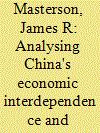

|
|
|
|
|
| Publication |
2012.
|
| Summary/Abstract |
This study examines the effects that economic interdependence has on political relations between China and its neighbours. Three economic liberal hypotheses are tested using data from the International Cooperation and Regional Conflicts dataset to measure dyadic political interaction along with economic data from the IMF and China Statistical Yearbooks and control variable data from Polity IV, COW CINC, among other sources. Though a significant amount of literature addresses the effects trade has on conflict at the systemic level, few studies address it at the dyadic level and even fewer test the pacification of trade on non-Western states. Examining economic, political, institutional, geographical, and political relations data from 1987 to 2001, this research tests the economic liberal hypothesis which posits that interdependence is associated with cooperative political relations between states. The findings show that trade interdependence is generally associated with political cooperation. However, the realist contention that relative power increases are associated with political conflict is also supported and analysed further.
|
|
|
|
|
|
|
|
|
|
|
|
|
|
|
|
| 3 |
ID:
073331
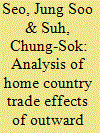

|
|
|
|
|
| Publication |
2006.
|
| Summary/Abstract |
A debate surrounds the trade impact of outward foreign direct investment (FDI), notably as to whether outward FDI complements or substitutes for a home countrys exports. This paper uses a fixed effect panel data econometric model to investigate the experience of Korean outward FDI in the ASEAN-4, during the 19872002 period. The results show that FDI stocks in ASEAN do not have discernable trade substituting effects on either Koreas exports or imports. However, it is found that contemporaneous FDI flows marginally contribute to Koreas exports to the region.
|
|
|
|
|
|
|
|
|
|
|
|
|
|
|
|
| 4 |
ID:
123399
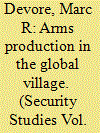

|
|
|
|
|
| Publication |
2013.
|
| Summary/Abstract |
Few issues are more important to international relations scholars than understanding how globalization is shaping the production of armaments. Within this context, this article examines both whether and how small and medium states can maintain defense-industrial bases capable of contributing to their national security. To preview the conclusion, although defense-industrial self-sufficiency has become an illusion for most states, even small and medium states can develop defense-industrial capabilities that enhance both their ability to autonomously employ their armed forces and secure access to foreign armaments. Moreover, governments possess a range of options for achieving these objectives, including a fundamental choice between accepting foreign direct investment and pursuing unrestrained arms exports. Governments unwilling to sanction foreign ownership of their defense industries can have recourse to unrestricted exports; alternatively, states uncomfortable with liberal exports can encourage foreign direct investment. With this in mind, a lasting diversity is likely to persist in even similarly endowed states' defense industries and defense-industrial policies.
|
|
|
|
|
|
|
|
|
|
|
|
|
|
|
|
| 5 |
ID:
134440
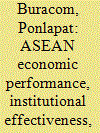

|
|
|
|
|
| Summary/Abstract |
Foreign direct investment (FDI) is considered to be one of the most important forces of economic growth and globalization. Many ASEAN economies have only a small domestic market; they are heavily reliant on international trade and FDI. Recent studies on cross-border investment indicate the importance of domestic economic performance and institutional effectiveness (including government effectiveness, regulatory quality, rule of law and property rights protection) in attracting FDI. The result from a cross-national empirical analysis, in this study, also confirms the significant impact of macroeconomic performance and institutional factors on FDI flows into developing countries. In this paper, it is argued that, with the exception of Singapore, most ASEAN countries are afflicted with relatively poor institutions for good governance, with low government effectiveness, and poor regulatory quality and rule of law. This relatively poor institutional quality may exacerbate the effects of external threats. As higher economic growth and better economic integration in other regions may divert FDI flows into ASEAN countries, their appropriate response is to improve institutional quality so that the share of FDI will increase in the total FDI inflows. Improving the institutional environment among ASEAN member countries should, therefore, be an important goal of ASEAN economic integration.
|
|
|
|
|
|
|
|
|
|
|
|
|
|
|
|
| 6 |
ID:
106009
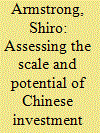

|
|
|
|
|
| Publication |
2011.
|
| Summary/Abstract |
The recent rise in Chinese outward direct investment (ODI) has significant global implications and impacts on host country policy. The present paper attempts to provide a theoretical basis and to define a robust econometric approach to assess the performance and potential of Chinese ODI. In this paper, foreign direct investment (FDI) performance is estimated using a frontier FDI model to measure how foreign investors, especially China, and the recipients of this direct investment perform relative to a benchmark of potential FDI. The results show that Chinese ODI achieves less of its potential compared with other investors. However, its ODI to Australia has performed much better than investment to other destinations. The results suggest that Chinese policy-makers should look at the pattern of China's ODI and, in light of superior performance in destinations like Australia, adjust policy strategies and institutional arrangements to enhance performance and reduce barriers to Chinese ODI.
|
|
|
|
|
|
|
|
|
|
|
|
|
|
|
|
| 7 |
ID:
167819
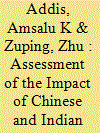

|
|
|
|
|
| Summary/Abstract |
In Africa, China and India are considered to be following a donor–recipient approach and are explicitly criticised for exploiting the continent’s energy resources. This study focuses on the presence of the Asian countries in terms of institutional theory, historical connections, instrumental motivations and political engagement with Africa in general, and with Ethiopia in particular. India offers non-pecuniary value, such as scholarship and technical assistance, whereas China focuses on a wider range of economic aids and non-pecuniary packages; thus, both countries are well positioned in Africa. This study is an exercise audit of the impact of Chinese and Indian economic activities on Ethiopia’s economic growth and examines the period from 1992 to 2016 from historical and contemporary perspectives. This study also includes a case study of members of Ethiopian society’s attitudes towards the presence and prospects of Chinese and Indian investment projects and its perceptions of these projects. Although some long-term developmental impacts remain uncertain, this study argues that the presence of the Asian drivers has favoured Ethiopia in many investment sectors and concludes that the overall impact of the Asian drivers on Ethiopia is beneficial. To collect primary data, individual and group interviews and discussions were conducted.
|
|
|
|
|
|
|
|
|
|
|
|
|
|
|
|
| 8 |
ID:
167638
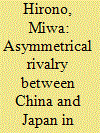

|
|
|
|
|
| Summary/Abstract |
To what extent is China–Japan rivalry a global phenomenon, and what is the nature of the rivalry they engage in outside their own region? Literature on Sino-Japanese rivalry abounds, but it pays scant attention to the relevance of the rivalry outside East Asia. This article argues that Sino-Japanese rivalry has indeed become a global phenomenon, that various forms of the rivalry are evident in Africa, and that they are mostly of an asymmetrical nature. Quantitatively, China’s contribution to Africa is far greater than that of Japan, with the exception of foreign direct investment (FDI). Qualitatively, though, Japan has a stronger sense of the rivalry than China has, revealing a psychological aspect to the asymmetry as well. Contextually, the types of activity that Chinese and Japanese actors carry out in Africa are not necessarily the same, which makes the rivalry all the more asymmetrical. The rivalry has become more apparent recently, not only because of the rise of China but also because of a change in the meaning of ‘Africa’ – from a region of ‘poverty’ and ‘hunger’ to a region of ‘economic opportunities’. That said, Africa – to a greater or lesser degree in each of its countries – still suffers from conflict and instability. As a result, the ability of Japan and China to exert power and influence throughout Africa is somewhat restricted.
|
|
|
|
|
|
|
|
|
|
|
|
|
|
|
|
| 9 |
ID:
069679


|
|
|
| 10 |
ID:
136060


|
|
|
|
|
| Summary/Abstract |
Like many other developing countries, South Asian nations have been experiencing increased foreign direct investment inflows over the past decade as developing countries get a larger share of cross-border investments that were once sent to developed countries. Nonetheless, South Asia’s inflows of foreign direct investment remain the lowest relative to gross domestic product among developing country regions. Why are South Asia’s foreign direct investment inflows so low and what lessons can be drawn for developing countries as a whole? The analysis in this article uses a novel empirical model that accounts for possible trends in convergence in the ratio of foreign direct investment to gross domestic product between countries and cross-sectional data for 78 countries from 2000 to 2011. The sample contains 52 developing countries. The analysis finds that two key factors are at work—high overall regulatory restrictions on foreign direct investment and specific restrictions placed on doing business with other countries. These factors include overall trade restrictiveness, which reduces the benefits to cross-border investments, and weak institutions to protect foreign investors and facilitate investment. Nonetheless, the potential for faster growth in intra- and inter-regional foreign direct investment flows is significant. The main factors leading to this conclusion are South Asia’s current low levels of foreign direct investment, the many unexploited opportunities for embodied knowledge transfer, and supply-chain linkages. The overall lessons for developing countries are that liberalizing policy constraints in both trade and foreign investment, keeping corporate tax rates modest, and improving governance and transparency could help to substantially improve foreign direct investment flows.
|
|
|
|
|
|
|
|
|
|
|
|
|
|
|
|
| 11 |
ID:
123623


|
|
|
|
|
| Publication |
2013.
|
| Summary/Abstract |
Nonstate actors, such as international non-governmental organizations (INGOs) and multinational corporations (MNCs), have attained an increasingly prominent role in modern world affairs. While previous research has focused on these actors' respective interactions with states, little attention has been paid to their interactions with each other. In this paper, we examine the extent to which the decisions of private actors seeking to invest abroad are affected by the reputational costs of doing business in countries publicly targeted by human rights activists. We find that ''naming and shaming'' by human rights INGOs tends to reduce the amount of foreign direct investment received by developing states, providing evidence that INGO activities affect the behavior of MNCs. An additional implication of our findings is that shaming by INGOs can impose real costs on targeted states in the form of lost investment.
|
|
|
|
|
|
|
|
|
|
|
|
|
|
|
|
| 12 |
ID:
135054
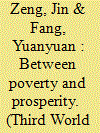

|
|
|
|
|
| Summary/Abstract |
Despite China’s rapid economic growth in the past three decades, Chinese officials and experts are increasingly worried that the country is slowly heading towards the ‘middle-income trap’. The fear is that China might suffer the same stagnation and turbulence as Latin American economies did in the 1980s and 1990s. Will China be able to avoid this trap? Building on the insights of world-systems theory, this paper argues that China’s dependent development, although enabling it to escape the ‘poverty trap’, is likely to bog it down in the ‘middle-income trap’. China’s heavy reliance upon foreign technologies and investment has harmful effects on its economy. Dependent development not only increases China’s economic vulnerability but also truncates domestic industries. To escape the trap, the Chinese state should play a more active role in shifting its growth model away from low-end commodity manufacturing to knowledge-based, high value-added activities.
|
|
|
|
|
|
|
|
|
|
|
|
|
|
|
|
| 13 |
ID:
185558
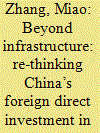

|
|
|
|
|
| Summary/Abstract |
Using a non-state-owned Chinese company LONGi as a case study, this paper analyses the motives, impact and acceptance of Chinese investment in Malaysia. The paper compares Chinese investment in manufacturing sector with the ones in infrastructure sector to obtain a more rigorous assessment than previous studies. In contrast to the narrative depicting Chinese investment into a single superstructure that generates a monolithic and deleterious impact couched under the Belt and Road Initiative, I argue that the motives and impacts of Chinese investment vary significantly with business nature and practices, and thus generating different acceptance level towards Chinese-funded project in host-site. LONGi’s case elucidates why Chinese investment in manufacturing encountered little political upheaval, while BRI projects in infrastructure sectors are often disputed. The analytical benefits and policy implications arising from this specific case study of Malaysia should be helpful to deepen our understanding of Chinese outward investment in not only other emerging economies in ASEAN but also broader region of the Asia-Pacific.
|
|
|
|
|
|
|
|
|
|
|
|
|
|
|
|
| 14 |
ID:
186335
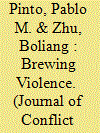

|
|
|
|
|
| Summary/Abstract |
Two prominent features in current world affairs are the unprecedented level of global economic integration and the growing incidence of intrastate violence. We develop and test a novel argument linking global integration through foreign investment to intrastate armed conflict. The presence of multinational corporations in developing countries can cause market concentration, resulting in high rents. Disputes between governments and would-be challengers over the appropriation of these rents are likely to turn violent, increasing the incidence of armed conflict. State capacity mitigates this positive association between foreign investment and intrastate war. Strong states have the capacity to deter rebellions, address citizens’ demands through institutionalized mechanisms, and credibly commit to the peaceful resolution of conflicts. Using data from developing countries for over four decades and addressing potential endogeneity and selection biases, we find strong support for our hypotheses. Our findings have important implications for understanding the link between economic interdependence and conflict.
|
|
|
|
|
|
|
|
|
|
|
|
|
|
|
|
| 15 |
ID:
138918
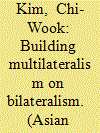

|
|
|
|
|
| Summary/Abstract |
In this article, I develop the multilateralism-through-bilateralism thesis by analyzing Asian bilateral investment treaties (BITs)—the idea that dense networks of bilateral agreements with similar contents provide the architecture for de facto multilateralism in regional economic governance. BIT networks are becoming increasingly dense and converging in content, and hence are analogous to a multilateral architecture for investment governance in the region. Key elements of this process are the degree of density and uniformity of BIT networks. Using the tool of social network analysis, I show that Asian BIT networks have become much denser, and they converge rather than diverge in terms of key provisions such as investment protection and dispute settlement procedures. I suggest that bilateralism is not necessarily a substitute for, or a stumbling block to, multilateralism, but should rather be viewed as another useful path toward multilateral governance.
|
|
|
|
|
|
|
|
|
|
|
|
|
|
|
|
| 16 |
ID:
168773
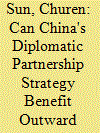

|
|
|
|
|
| Summary/Abstract |
In the context of global integration, whether a diplomatic partnership strategy can promote outward foreign direct investment (OFDI) and how it works are very important issues for China. Based on a dataset featuring China's partnerships collected from the Ministry of Foreign Affairs website, we establish an empirical framework to assess the role of China's diplomatic strategy in its OFDI arising from partnerships since 1993. The results show that the establishment or upgrade of partnerships has had a positive effect on Chinese firms’ decisions on OFDI for at least the short term, especially for firms with higher demand for policy guarantees from the government, such as non‐central firms and non‐Beijing firms. The results also show that the increase in OFDI is concentrated in host countries with higher political risks, such as developing countries, neighboring countries, and Belt and Road countries, which is consistent with China's diplomatic focus. Our research proves that China's diplomatic strategy can assist firms to invest abroad.
|
|
|
|
|
|
|
|
|
|
|
|
|
|
|
|
| 17 |
ID:
101163
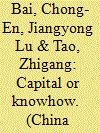

|
|
|
|
|
| Publication |
2010.
|
| Summary/Abstract |
China's success in attracting foreign direct investment has been cast in doubt as mainly a transfer of capital, not knowhow, because its financial system is incapable of allocating domestic savings and hard-earned foreign reserves to domestic enterprises. To shed light on this debate, we examine the determinants of equity sharing in Sino-foreign joint ventures with the premise that the roles of foreign direct investment (in transferring capital or knowhow) should be reflected in equity sharing between multinational firms and local firms. Our empirical analysis offers strong evidence for foreign direct investment as a transfer of knowhow, but limited support for foreign direct investment as a transfer of capital, which points to the need for further reform in China's financial system.
|
|
|
|
|
|
|
|
|
|
|
|
|
|
|
|
| 18 |
ID:
075412
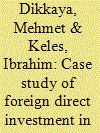

|
|
|
| 19 |
ID:
175348


|
|
|
|
|
| Summary/Abstract |
This article aims to understand the drivers of foreign direct investment (FDI) inflows and its nexus with its determinants such as economic growth, inflation rate, labour productivity, infrastructure development, market size, openness of the economy, political stability and corporate tax for South Asian Association for Regional Corporation (SAARC) countries. The article is based on secondary data from the World Bank and International Labour Organization (ILO) for 19 years from 2001 to 2018 for 6 SAARC countries, viz. Bangladesh, Bhutan, India, Nepal, Pakistan and Sri Lanka. The findings indicate that there exists long-run, short-run and joint causal relationship among infrastructure development, market size, openness of the economy, political stability and corporate tax and FDI inflows. Among these variables, the corporate tax is the most important one because it shows bidirectional causality with FDI inflows in the long run as well as short run along with joint strong causality. However, only the coefficients of infrastructure development and corporate tax were found to be positively and negatively significant, respectively. Therefore, better infrastructure development and decrease in corporate tax may enhance FDI inflows in SAARC countries. This infers that with the decrease in corporate tax, more FDI inflows may take place, and higher FDI inflows may decrease in corporate tax further. Therefore, this article suggests that SAARC countries should accelerate the process of integration of their economy with the rest of the world along with political stability, enhance the infrastructure facility and reduce the corporate tax to get the higher FDI inflows.
|
|
|
|
|
|
|
|
|
|
|
|
|
|
|
|
| 20 |
ID:
149049
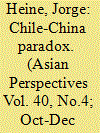

|
|
|
|
|
| Summary/Abstract |
Chile, a country that has been at the forefront of Latin America’s growing links with China, embodies a paradox in terms of Chinese outward foreign direct investment (COFDI). On the one hand, bilateral trade has thrived, increasing fourfold since the signing of a free trade agreement in 2005, turning Chile into China’s third largest trading partner in the region. On the other hand, Chinese direct investment in Chile has been low, much lower than in neighboring countries. In this article I explore the roots of this upsurge in bilateral trade while also explaining the reasons for the dearth of Chinese investment in a country traditionally considered to be attractive to foreign investors. Chile might be a victim of its own success as its economic accomplishments allow it to persist with investment policies that are currently daunting to Chinese investors.
|
|
|
|
|
|
|
|
|
|
|
|
|
|
|
|
|
|
|
|
|